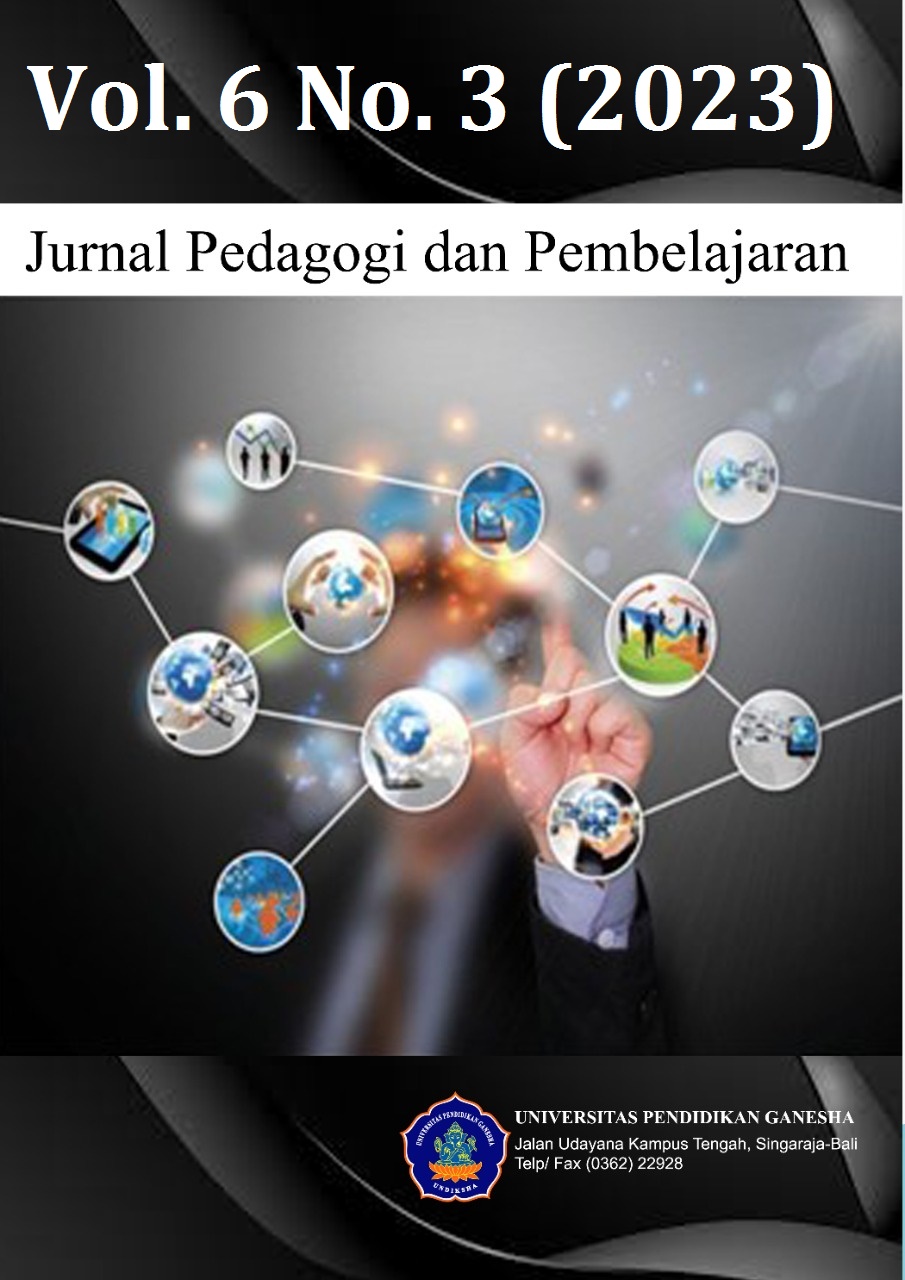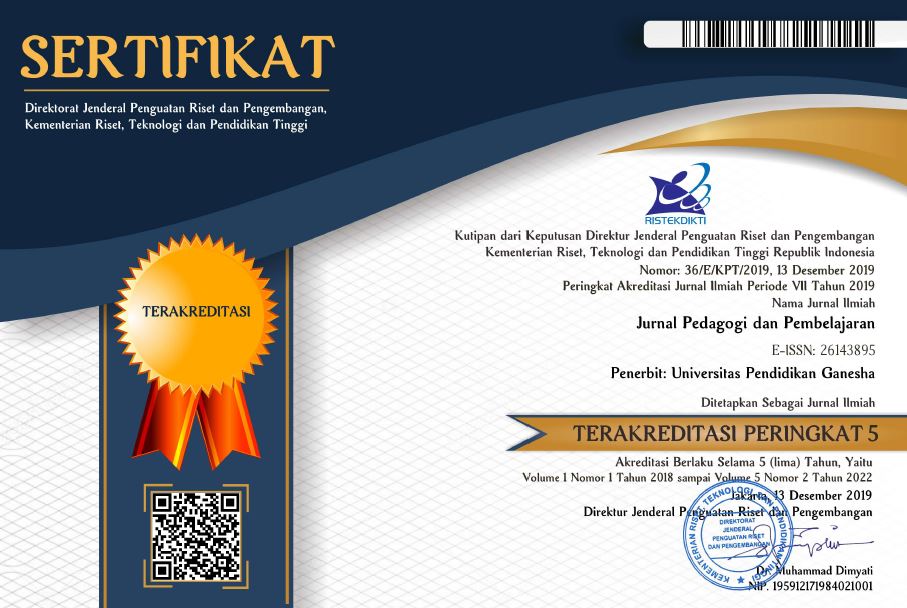Interactive Multimedia Based on the PjBL Model with Public Health Orientation Assisted by Articulate Storyline 3
DOI:
https://doi.org/10.23887/jp2.v6i3.59640Keywords:
Development, Interactive Multimedia, Pjbl, Learning OutcomesAbstract
Lack of learning media and models and declining learning outcomes in science learning. This research aims to develop PjBL-based Interactive Multimedia with a public health orientation on Human Respiratory System material for class V elementary school that is feasible, practical, and effective for improving student learning outcomes. This type of research is Research and Development with the ADDIE model. The subjects of this research were two media experts, two material experts, three teachers and six students, and 1 class V group of 34 students. The data analysis techniques used are descriptive, qualitative, and quantitative. The data collection methods were questionnaires and tests with instruments such as rating scale sheets and multiple-choice tests. The research design used was a pre-experimental, one-shot case study. The research results show that the media prototype developed consists of 3 main parts, namely the opening, initial, and prominent displays. The media suitability index is categorized as high, and the average material test score is very decent. The results of the practicality test by teachers are high, and the practicality test by students are categorized as very good. Interactive Multimedia based on the PjBL model was declared effective in improving the learning outcomes of fifth-grade elementary school students. It was concluded that the media developed was feasible, practical, and effective in improving student learning outcomes in the Human Respiratory System material for class V elementary school.
References
Anggraini, PD, & Wulandari, SS (2020). Analysis of the Use of Project Based Learning Models in Increasing Student Activity. Journal of Office Administration Education (JPAP), 9(2), 292–299. https://doi.org/10.26740/jpap.v9n2.p292-299.
Angreni, S., & Sari, RT (2018). The Complexity integrated-Instruments components media of IPA at Elementary School. SHS Web of Conferences, 42, 6. https://doi.org/https://doi.org/10.1051/shsconf/20184200120.
Artha, WA, & Putra, the good god Ketut Ngurah. (2021). Development of Audio Visual Media Using the Analysis Design Development Implementation Evaluation Model for Class IV Science Content at SD Negeri 2 Pejeng for the 2020/2021 Academic Year. Undiksha Edutech Journal, 9(1), 149–157. https://doi.org/10.23887/jeu.v9i1.32974.
Aryani, NW, & Ambara, DP (2021a). Interactive multimedia-based learning videos on the cognitive aspects of early childhood. Journal of Early Childhood Education Undiksha, 9(2), 252–260. https://doi.org/10.23887/paud.v9i2.36043.
Aryani, NW, & Ambara, DP (2021b). Interactive Multimedia Based Learning Videos on Cognitive Aspects of Early Childhood. Journal of Early Childhood Education Undiksha, 9(2), 252. https://doi.org/10.23887/paud.v9i2.36043.
Badiah, Umi, et al. (2020). Study of the Problem of Student Activeness in Class VI Science Learning at SDN Socah 4 Bangkalan Regency. National Education Proceedings, 1(1), 169–174.
Elisabet, & et al. (2019). Increasing Motivation and Science Learning Results by Using the Project Based Learning (PjBL) Learning Model. Journal of Educational Action Research, 3(3), 285. https://doi.org/10.23887/jear.v3i3.19451.
Fransiska, J., Mariam, P., & Hikmah, N. (2023). Education Management in the Independent Curriculum in Elementary Schools. Journal of Educational Management, 11(1), 78–90. https://doi.org/https://doi.org/10.31958/jaf.v10i1.8696.
Friedman, K., Lou, Y., & Ma, J. (2020). Changing Design Education for the 21st Century. She Ji: The Journal of Design, Economics, and Innovation, 6(1), 1–4. https://doi.org/10.1016/j.sheji.2020.02.002.
Hanifah Salsabila, U., Irna Sari, L., Haibati Lathif, K., Puji Lestari, A., & Ayuning, A. (2020). The Role of Technology in Learning During the Covid-19 Pandemic. Al-Mutharahah: Journal of Social Religious Research and Studies, 17(2), 188–198. https://doi.org/10.46781/al-mutharahah.v17i2.138.
Iasha, V. (2022). How is the Character Education Implemented? The Case Study in Indonesian Elementary School How is the Education Character Implemented? The Case Study in Indonesian Elementary School. February. https://doi.org/10.36941/jesr-2022-0029.
Indarta, Y., & et al. (2022). The Relevance of the Independent Learning Curriculum with the 21st Century Learning Model in the Development Era of Society 5.0. Educative: Journal of Educational Sciences, 4(2), 3011–3024. https://doi.org/10.31004/edukatif.v4i2.2589.
Ingtiyasningsih, Puji, et al. (2022). Effectiveness of the Project Based Learning Model to Increase Student Creativity in Class V of Kepatihan State Elementary School. Paedagoria: Journal of Educational Studies, Research and Development, 13(2), 210. https://doi.org/10.31764/paedagoria.v13i2.10605.
Irfana, Saidatul, D. (2022). The Effectiveness of the Project Based Learning (PjBL) Learning Model in Increasing Student Interest and Learning Outcomes in Elementary Schools. Journal of Professional Elementary Education, 6(2), 56–64. https://doi.org/10.46306/jpee.v1i1.8.
Mawanto, A. (2022). The Influence of Learning Video Media on Science Learning Outcomes on Water Cycle Material for Class V of Lontar II State Elementary School, Surabaya. Journal on Education, 04(04), 1264–1271. https://doi.org/10.31004/joe.v4i4.542.
Mayuni, Komang Ratna, et al. (2019). The Influence of the Project Based Learning (PjBL) Learning Model on Science Learning Outcomes. Scientific Journal of Teacher Professional Education, 2(2), 183–193. https://doi.org/10.24114/inpafi.v5i1.6597.
Miftah, M. (2013). Functions and Role of Learning Media as an Effort to Improve Student Learning Abilities. Kwangsan Journal, 1(2), 95. https://doi.org/10.31800/jurnalkwangsan.v1i2.7.
Nasrudin, & Roslina. (2019). Providing structured assignments to improve mathematics learning outcomes for class xi vocational school students. Journal of Mathematics Education, 3(1), 1–13. https://doi.org/http://dx.doi.org/10.31100/histogram.v3i1.284.
Naziah, ST, Maula, LH, & Sutisnawati, A. (2020). Analysis of Student Learning Activeness During Online Learning during the Covid-19 Period in Elementary Schools. JPSD Journal, 7(2), 109–120. https://doi.org/http://dx.doi.org/10.26555/jpsd.
Nisah, Nurul, et al. (2021). The Effectiveness of the Project Based Learning Model in Improving Science Learning Outcomes in Elementary Schools. 8(November), 114–126. https://doi.org/10.25134/pedagogi.v8i2.4882.
Nugraheni, N. (2017). Application of Comic Media in Mathematics Learning in Elementary Schools. Educational Reflections: Educational Scientific Journal, 7(2), 111–117. https://doi.org/10.24176/re.v7i2.1587.
Prakoso, AF, Andriansyah, EH, Rafsanjani, MA, Nurlaili, I., & Arif, A. (2023). Education in Indonesia (Merdeka Curriculum) and Japan Curriculum : What's the Difference? Journal of Research Results and Literature Review in the Field of Education, Teaching and Learning, 9(1), 162–173. https://doi.org/https://doi.org/10.33394/jk.v9i1.6992.
Pratama, IP utu A., & Sujana, IW (2022). Interactive Learning Media Based on Project Based Learning on Ethnic Diversity in Indonesia. Scientific Journal of Education and Learning, 6(2), 317–329. https://doi.org/https://doi.org/10.23887/jipp.v6i2.47377.
Purnamasari, NL (2020). Addie's Method for Developing Interactive Media Adobe Flash on Tik Subjects. Journal of Education and Learning for Elementary School Children, 5(1), 23–30. https://doi.org/10.29100/jpsd.v5i1.1530.
Puspitarini, YD, & Hanif, M. (2019). Using Learning Media to Increase Learning Motivation in Elementary School. Anatolian Journal of Education, 4(2), 53–60. https://doi.org/10.29333/aje.2019.426a.
Putranadi, Ketut, et al. (2021). Development of Learning Media on Human Respiratory and Excretory Structures for Xi Science Class at Sma Negeri 2 Singaraja. Collection of Articles from Informatics Engineering Education Students (KARMAPATI), 10(3), 300. https://doi.org/10.23887/karmapati.v10i3.36773.
Rahmadayanti, D., & Hartoyo, A. (2022). Portrait of the Independent Curriculum, the Form of Independent Learning in Elementary School. Basicedu Journal, 6(4), 7174–7187. https://doi.org/10.31004/basicedu.v6i4.3431.
Raja, R., & Nagasubramani, P.C. (2018). Impact of modern technology in education. Journal of Applied and Advanced Research, 3(1), 33–35. https://doi.org/https://dx.doi.org/10.21839/jaar.2018.v3S1.165.
Ratheeswari, K. (2018). Information Communication Technology in Education. Journal of Applied and Advanced Research, 3(1), 45–47. https://doi.org/https://dx.doi.org/10.21839/jaar.2018.v3S1.169 ISSN.
Sari, RT, & Angreni, S. (2018). Implementation of the Project Based Learning (PjBL) Learning Model to Increase Student Creativity. VARIDIKA Journal, 30(1), 79–83. https://doi.org/10.23917/varidika.v30i1.6548.
Setiawan, HR, Rakhmadi, AJ, & Raisal, AY (2021). Development of Black Hole Teaching Media Using the ADDIE Development Model. Journal of Coil Physics, 4(2), 112–119. https://doi.org/10.33369/jkf.4.2.112-119.
Sugihartini, N., & Yudiana, K. (2018). ADDIE as a model for developing educational instructional media (MIE) for curriculum and teaching subjects. Journal of Technology and Vocational Education, 15(2). https://doi.org/10.23887/jptk-undiksha.v15i2.14892.
Sumarni, I. (2020). Implementation of the Project Based Learning (Pjbl) Model to Improve Student Activities and Learning Outcomes in Science Subjects Concerning the Properties of Light in Class V a Semester II for Elementary School Students in Bantardekang 1 Academic Year 2017/2018. Journal of Educational Technology, 9(1). https://doi.org/10.32832/tek.pend.v9i1.2764.
Sumendap, R. (2022). The Role of Public Relations Between Schools and the Community to Improve the Quality of Education in Elementary Schools. Journal of Nonformal Education Science, 08(1), 655–662. https://doi.org/http://dx.doi.org/10.37905/aksara.8.1.655-662.2022.
Suparlan, S. (2019). Constructivism Theory in Learning. Islamika, 1(2), 79–88. https://doi.org/10.36088/islamika.v1i2.208.
Triwardhani, D. (2022). Optimizing Human Resources Management for Higher Education in the Era of Implementing an Independent Curriculum in Indonesia. Iqra Journal of Educational Studies, 7(2), 246–259. https://doi.org/https://doi.org/10.25217/ji.v7i2.1803.
Wahyuni, S. (2022). Research in Business & Social Science Implementation of the new higher education curriculum in Indonesia: Perceptions and participation. International Journal of Research in Business and Social Science, 11(3), 227–239. https://doi.org/https://doi.org/10.20525/ijrbs.v11i3.1713.
Wahyuningtyas, R., & Sulasmono, BS (2020). The Importance of Media in Learning to Improve Learning Outcomes in Elementary Schools. Educative: Journal of Educational Sciences, 2(1), 23–27. https://doi.org/10.31004/edukatif.v2i1.77.
Widiantono, N. (2017). Implementation of an Interactive Learning Model to Improve Science Learning Activities and Outcomes for Grade 5 Elementary School Students. Scholaria: Journal of Education and Culture, 7(3), 199. https://doi.org/10.24246/j.scholaria.2017.v7.i3.p199-213.
Zaharah, Z., & Susilowati, A. (2020). Increasing Students' Learning Motivation Using Electronic Module Media in the Era of Industrial Revolution 4.0. Biodic, 6(2), 145–158. https://doi.org/10.22437/bio.v6i2.8950.
Downloads
Published
How to Cite
Issue
Section
License
Copyright (c) 2023 Ni Luh Trisna Ari Utami

This work is licensed under a Creative Commons Attribution-ShareAlike 4.0 International License.
Authors who publish with Jurnal Pedagogi dan Pembelajaran agree to the following terms:
- Authors retain copyright and grant the journal the right of first publication with the work simultaneously licensed under a Attribution-ShareAlike 4.0 International (CC BY-SA 4.0) that allows others to share the work with an acknowledgment of the work's authorship and initial publication in this journal
- Authors are able to enter into separate, additional contractual arrangements for the non-exclusive distribution of the journal's published version of the work (e.g., post it to an institutional repository or publish it in a book), with an acknowledgment of its initial publication in this journal.
- Authors are permitted and encouraged to post their work online (e.g., in institutional repositories or on their website) prior to and during the submission process, as it can lead to productive exchanges, as well as earlier and greater citation of published work. (See The Effect of Open Access)











